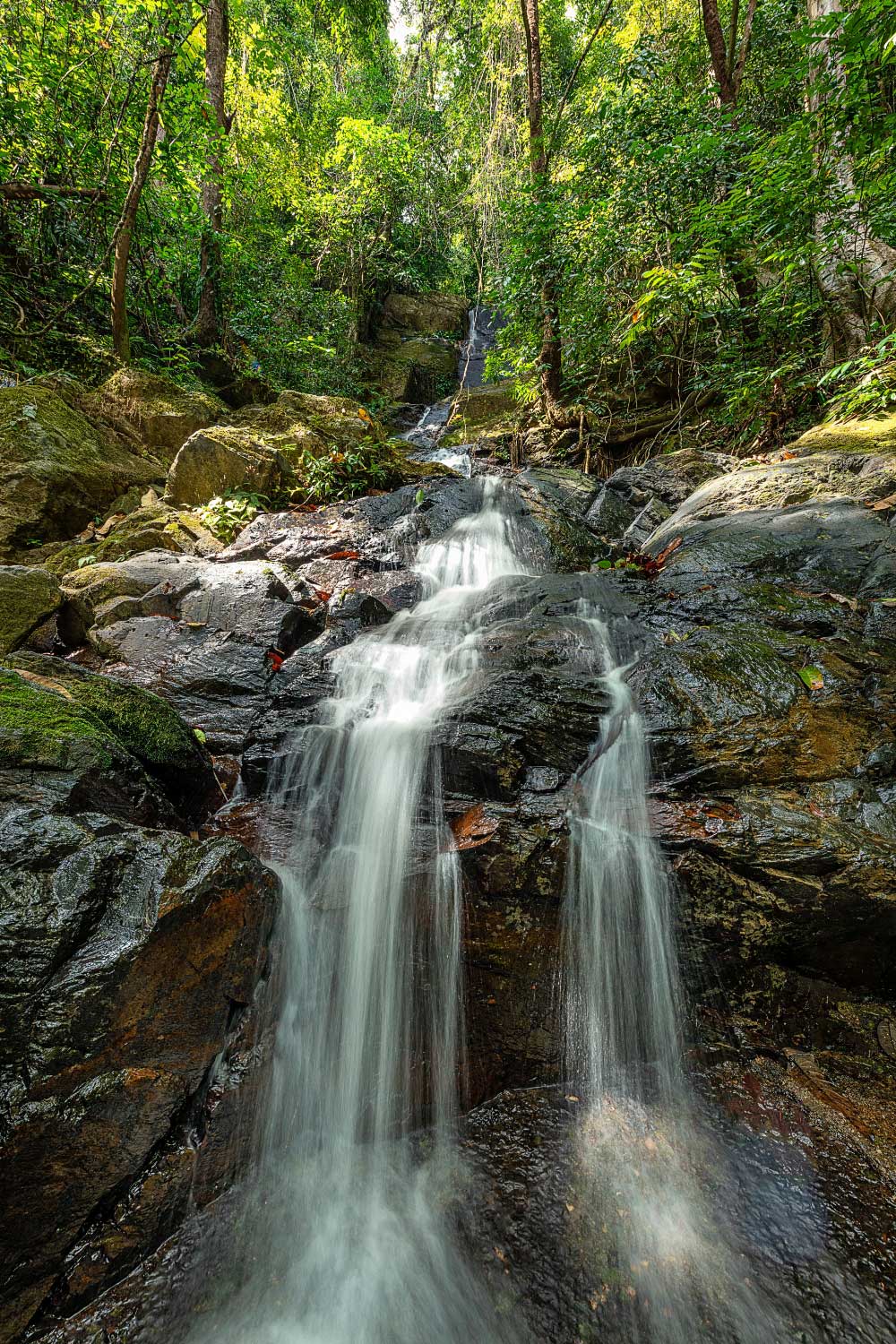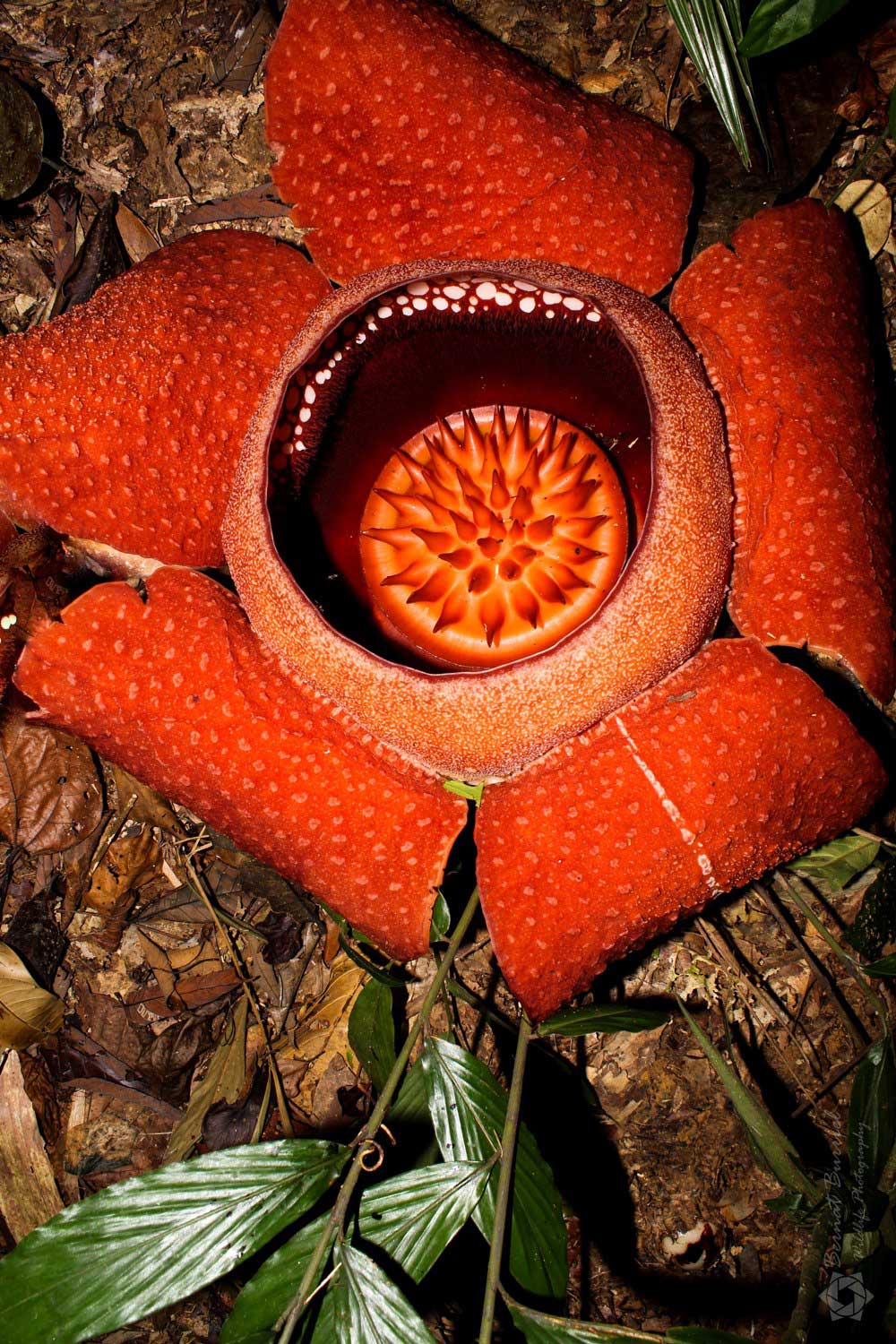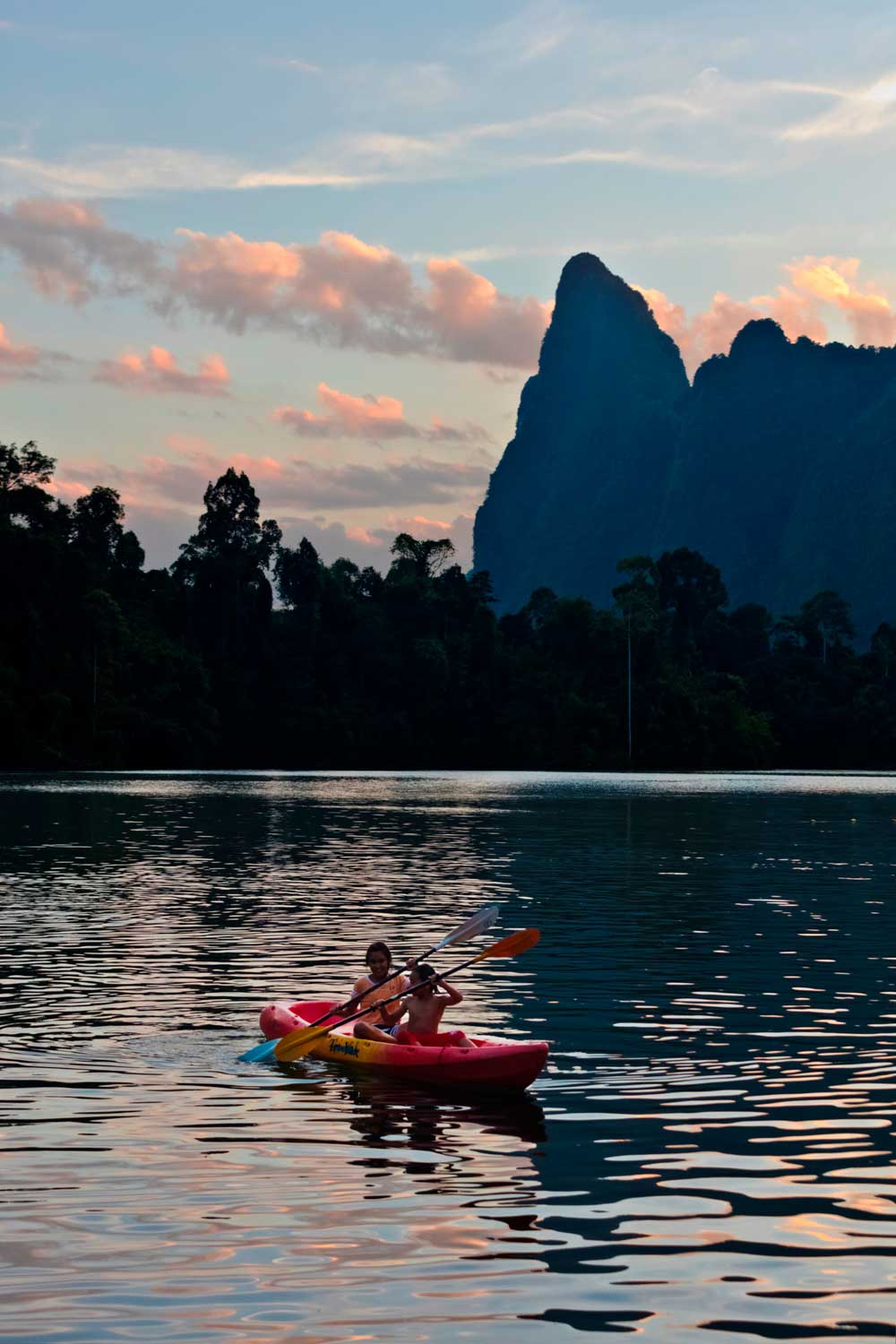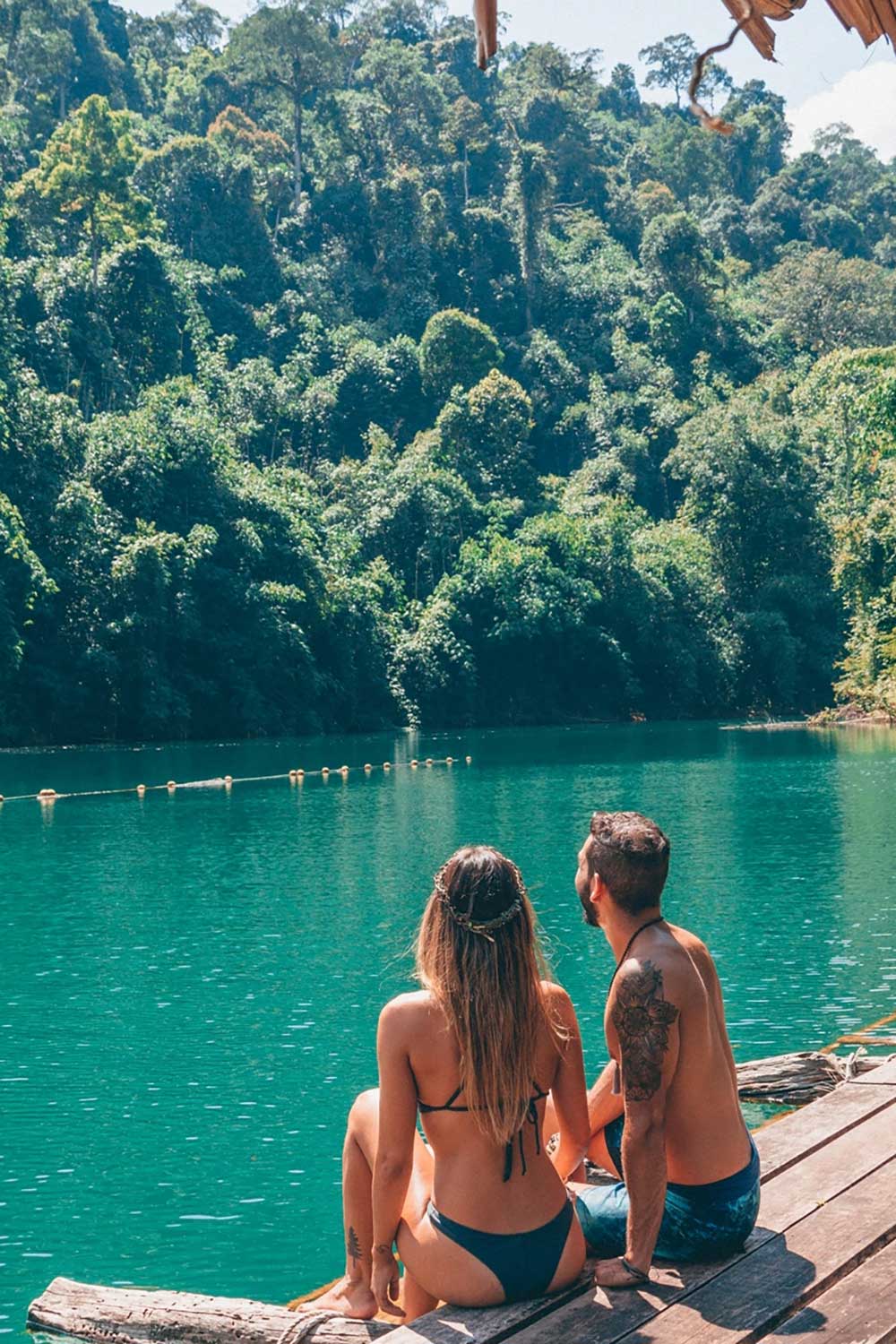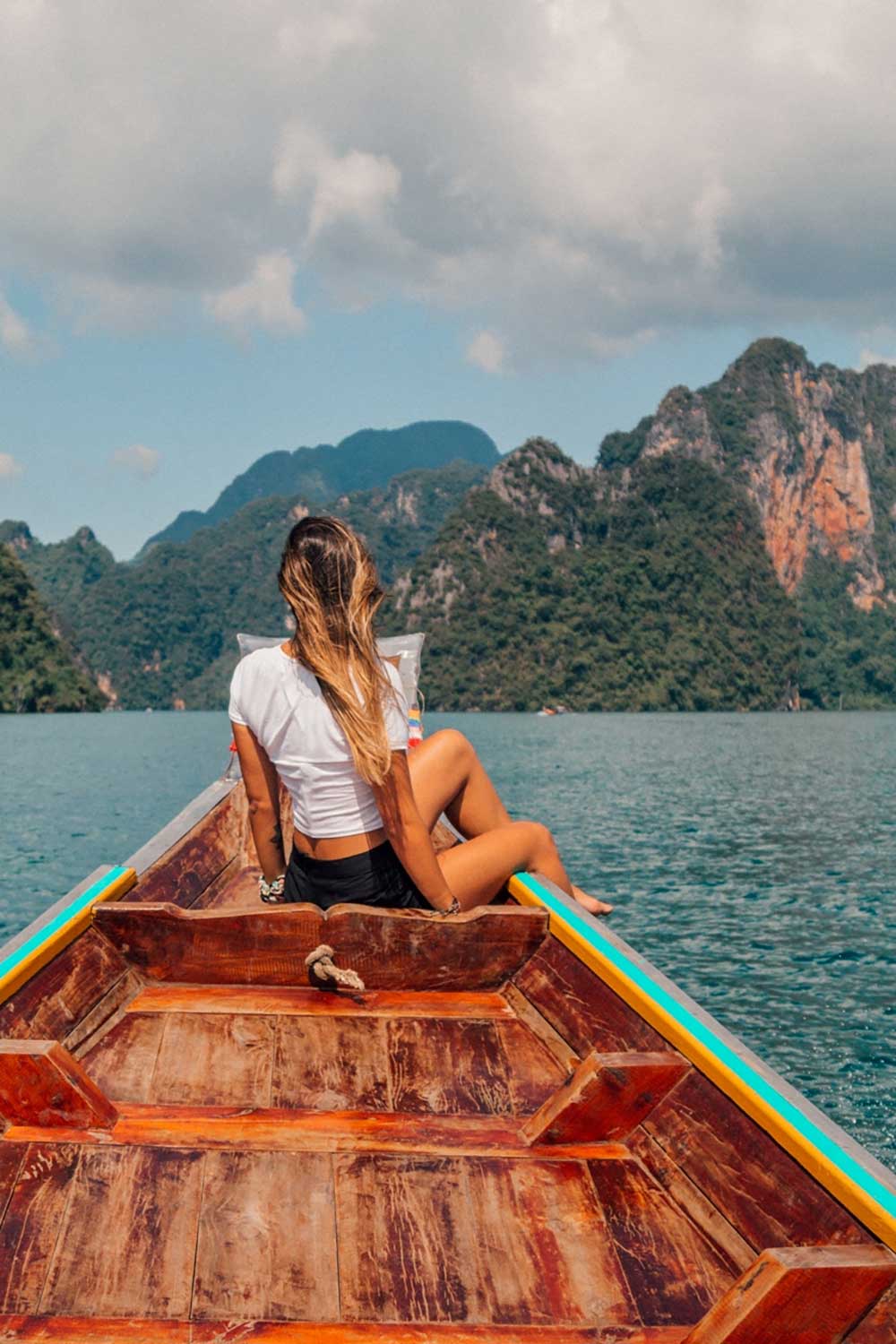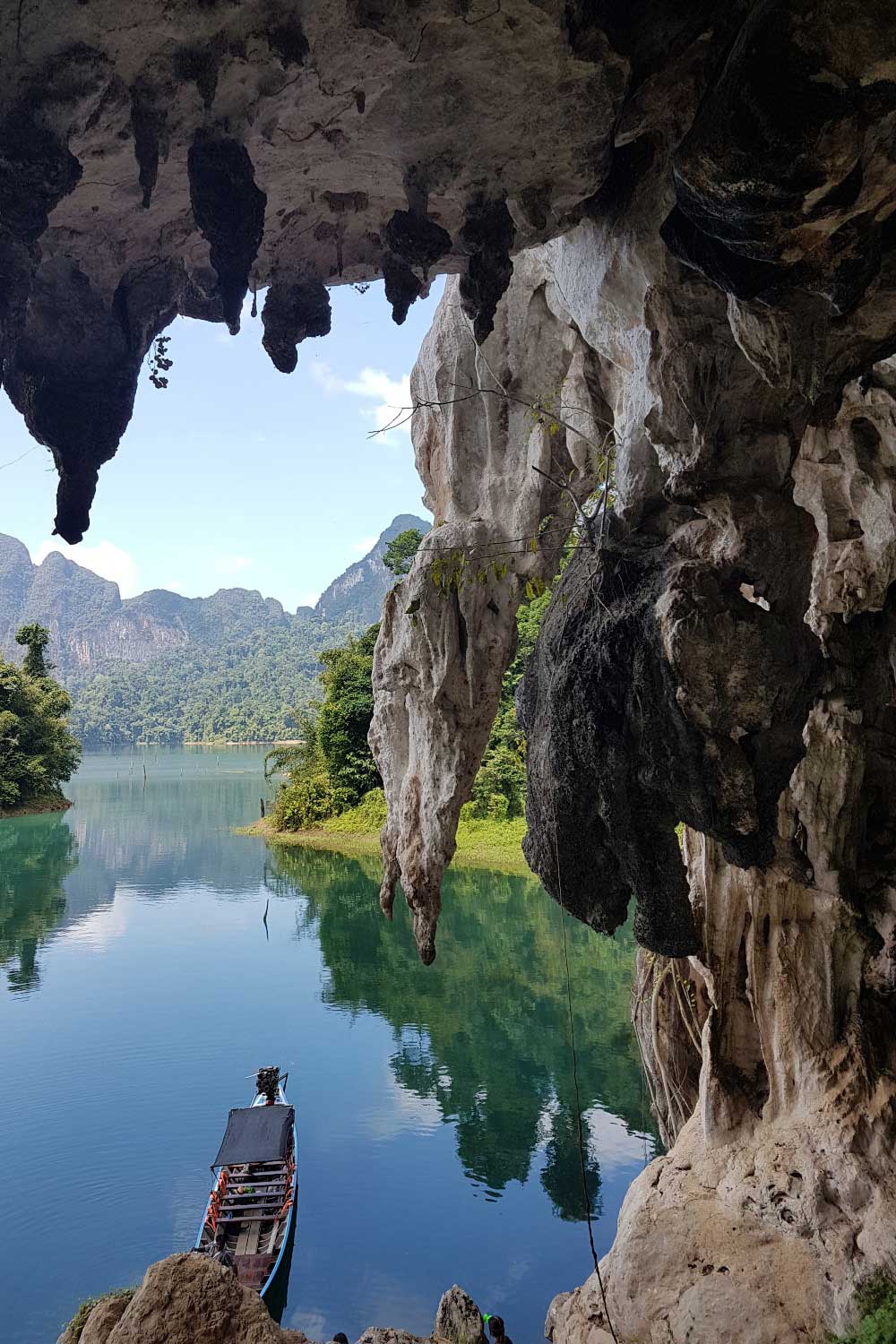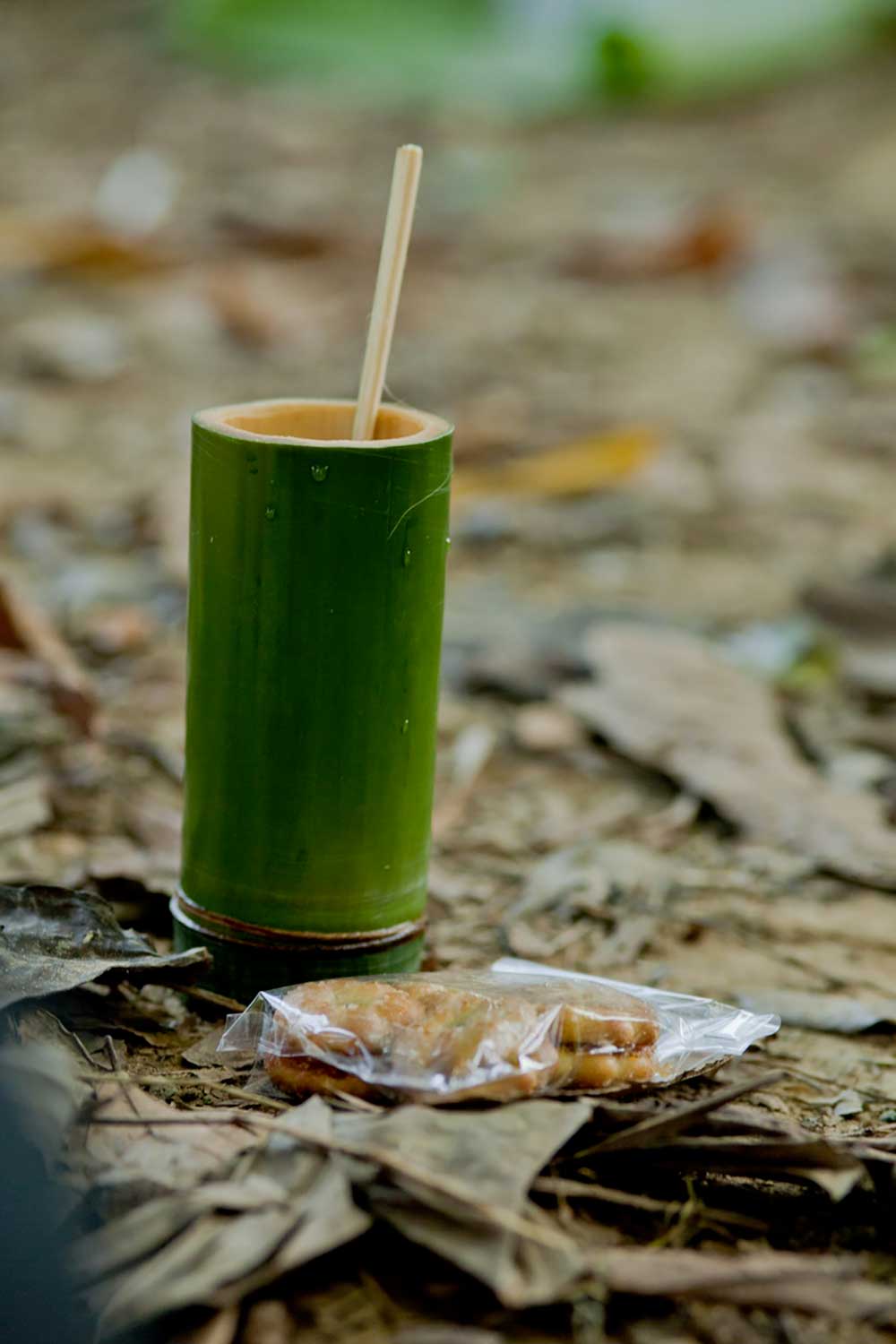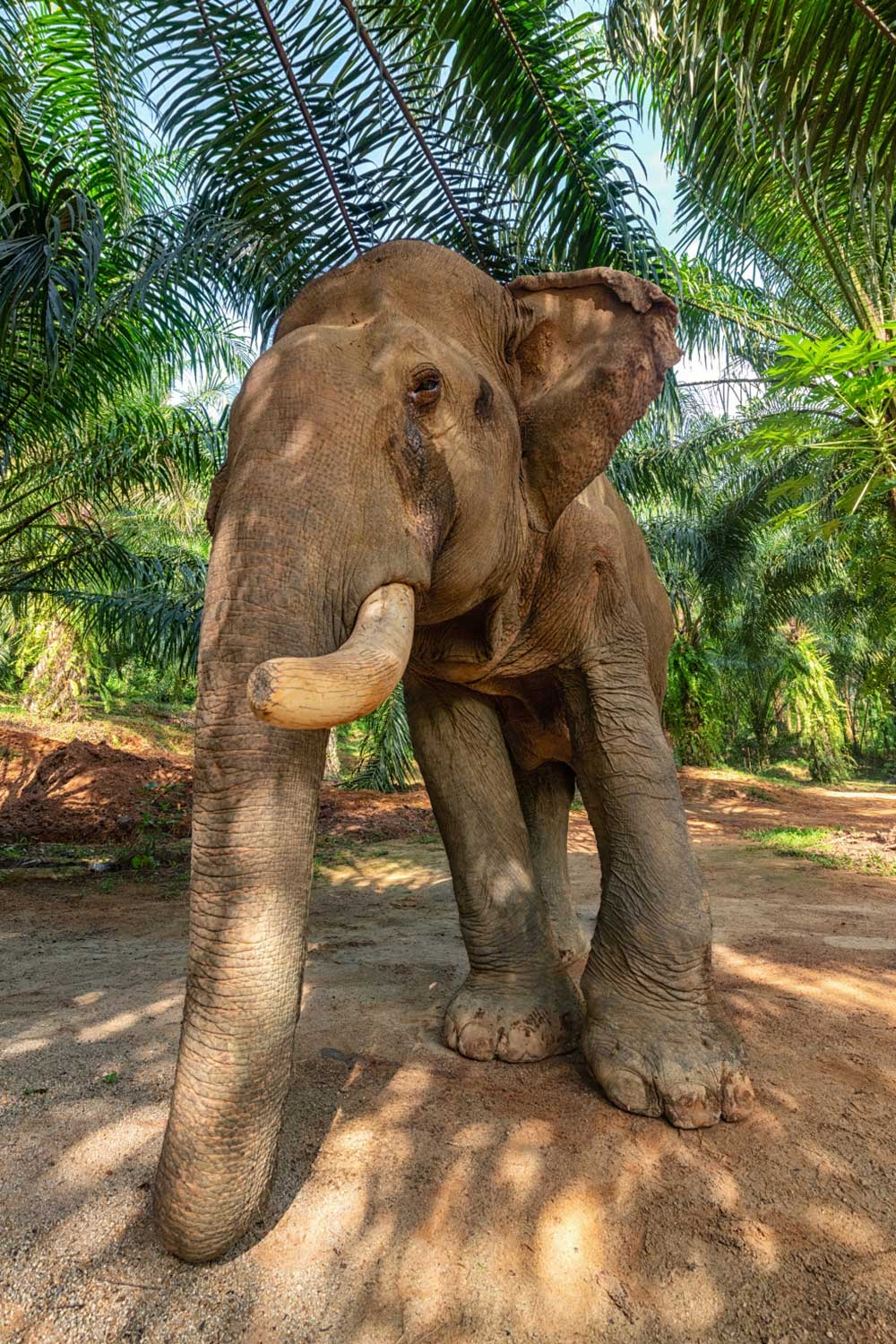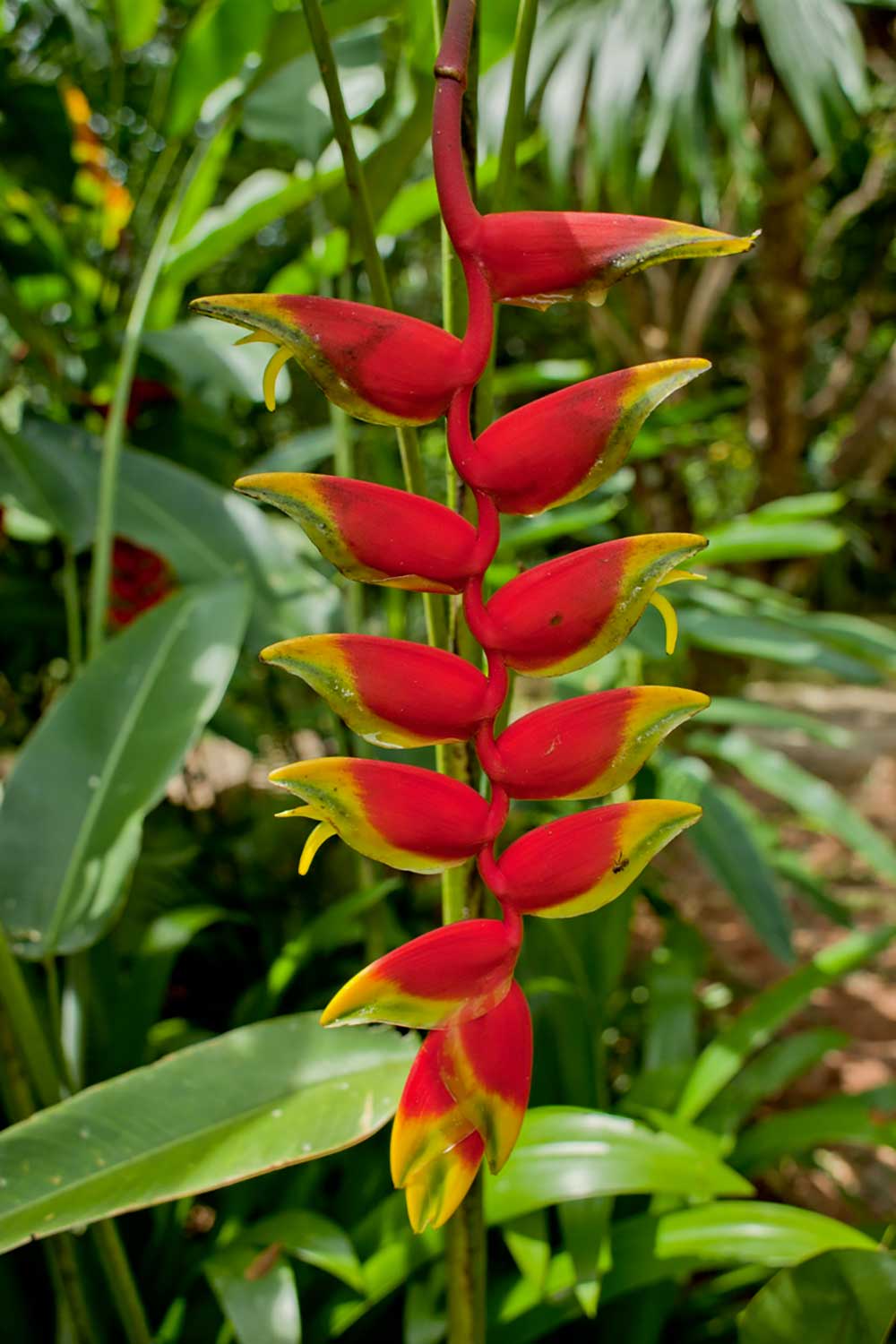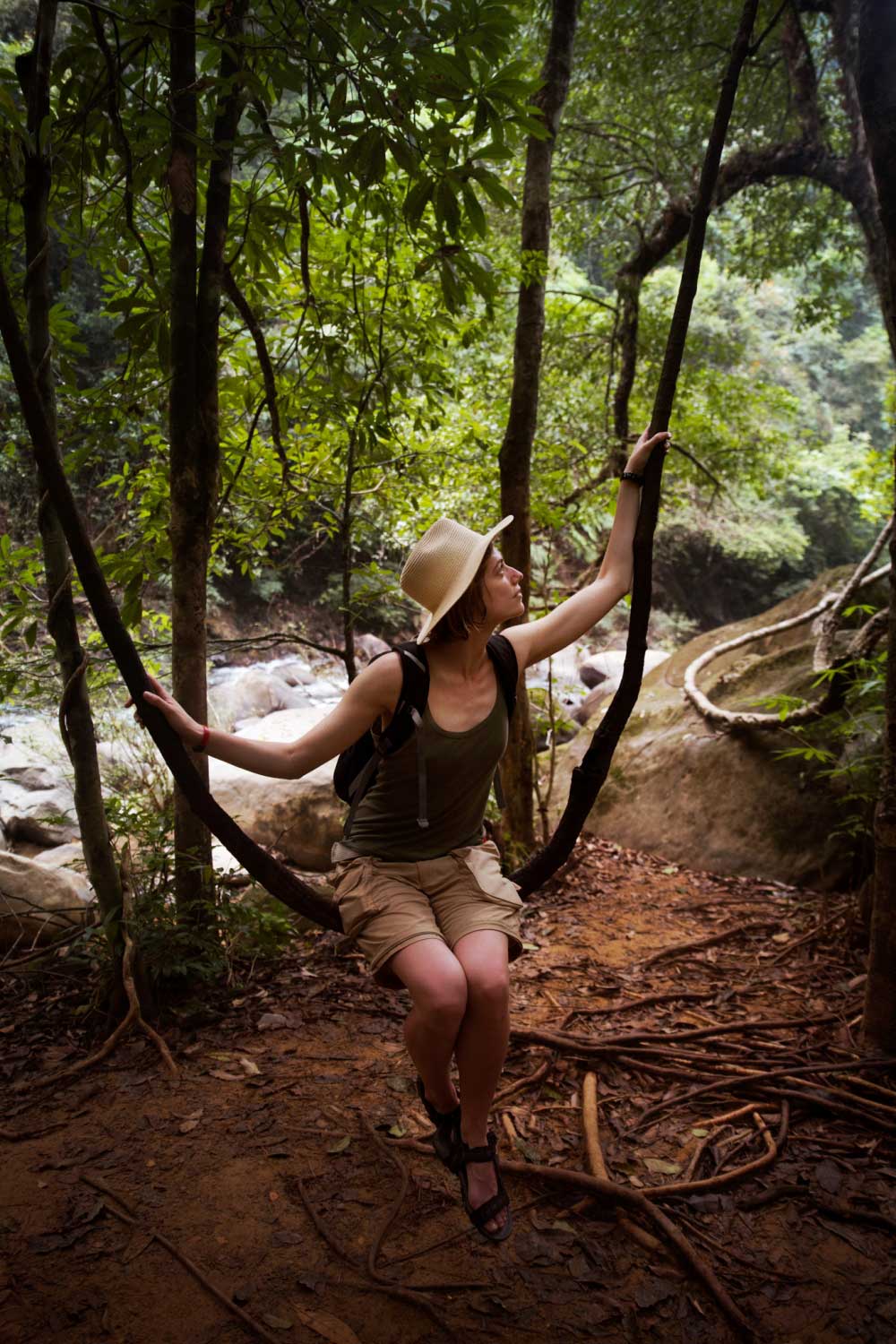Khao Sok National Park video featuring Khao Sok Lake – courtesy of ContemporaryNomad – View full video here
Overview and History of Khao Sok National Park
INTRODUCTION
Home to the world’s oldest jungle ecosystem, Khao Sok National Park and surrounding area form a protected region of over 3,600 square kilometers. It features the amazing Khao Sok lake, pristine jungle, waterfalls and swimming holes, and eye-catching limestone cliffs that rise sharply from the green canopy. This page starts with a brief overview of the park, and goes on to detail the Khao Sok national park location as well as the human and natural history of the area.
Overview of Khao Sok National Park
The Khao Sok National Park has two main centers of activity at: the headquarters at Khao Sok town and the floating bungalows of Khao Sok Lake (Lake Cheow Larn), 65km to the east. Near the headquarters, hiking, river activities and elephant treks can be found, along with accommodation. Additionally, the lake can be visited on a day tour or you can stay overnight in a floating bungalow.
Park Highlights – Wildlife and Unique Flora
Khao Sok nationalpark is home to gibbons, elephants, 5 types of monkey, plus several rare bird species. Notably, it is one of the few places to see species native to both the Malayan peninsula and the rest of Southeast Asia. The best time to see big animals is between February and May. The park also contains unusual plants, such as the Rafflesia. This is the world’s largest flower, with a diameter of almost a meter, and blooms periodically between December and March. As a result, a Rafflesia trek is one of Khao Sok’s most unique adventures.
Best time to visit Khao Sok National Park
Since many of Khao Sok’s classic activities require rain, you can visit the National Park all year. The “green season” is from May to October. Within this time, periods of wet and dry weather alternate. Most rain falls in June and September. Consequently, this is the best time for river tubing. Finally, from November through April the weather is generally dry and sunny. For more information on the Khao Sok dry season, click here.
Your Accommodation in Khao Sok
After exploring Khao Sok National Park, our comfortable rooms provide the perfect place to relax. You will sleep in a private cottage, and can enjoy a tasty meal and cold beer in our restaurant. Riverside Cottages makes an excellent base to experience the National Park and khao Sok lake. Please contact us to book a room or a tour package.
INTRODUCTION
Home to the world’s oldest jungle ecosystem, Khao Sok National Park and surrounding area form a protected region of over 3,600 square kilometers. It features pristine jungle, waterfalls and swimming holes, and eye-catching limestone cliffs that rise sharply from the green canopy. This page starts with a brief overview of the park, and goes on to detail the Khao Sok national park location as well as the human and natural history of the area.
Overview of Khao Sok National Park
The Khao Sok National Park has two main centers of activity at: the headquarters at Khao Sok town and the floating bungalows of Khao Sok lake (Cheow Larn Lake), 65km to the east. Near the headquarters, hiking, river activities and elephant treks can be found, along with accommodation. Additionally, the lake can be visited on a day tour or you can stay overnight in a floating bungalow.
Park Highlights – Wildlife and Unique Flora
Khao Sok nationalpark is home to gibbons, elephants, 5 types of monkey, plus several rare bird species. Notably, it is one of the few places to see species native to both the Malayan peninsula and the rest of Southeast Asia. The best time to see big animals is between February and May. The park also contains unusual plants, such as the Rafflesia. This is the world’s largest flower, with a diameter of almost a meter, and blooms periodically between December and March. As a result, a Rafflesia trek is one of Khao Sok’s most unique adventures.
Best time to visit Khao Sok National Park
Since many of Khao Sok’s classic activities require rain, you can visit the National Park all year. The “green season” is from May to October. Within this time, periods of wet and dry weather alternate. Most rain falls in June and September. Consequently, this is the best time for river tubing. Finally, from November through April the weather is generally dry and sunny. For more information on the Khao Sok dry season, click here.
Your Accommodation in Khao Sok
After exploring Khao Sok National Park, our comfortable rooms provide the perfect place to relax. You will sleep in a private cottage, and can enjoy a tasty meal and cold beer in our restaurant. Riverside Cottages makes an excellent base to experience the National Park. Please contact us to book a room or a tour package.
khao Sok national park location
The khao Sok national park location in Thailand’s Surat Thani province extends into parts of the Khlong Yee and Khlong Pra Sang parks, and even portions of the neighboring districts. The combined sizes of Khao Sok and bordering areas is over 3,500 square kilometers!
How to get here
- Private Transfers
- Bangkok to Khao Sok
- Phuket to Khao Sok
- Surat Thani to Khao Sok
What’s in the park?
Khao Sok national park was established in as Thailand’s 22nd National Park in 1980. The park is 739 square kilometres in size and adjoins several other protected areas to form Thailand’s largest (and last) uninhabited wilderness. It consists of thick forest, waterfalls, limestone cliffs (known as karsts) and an island studded lake. While the lake itself may be only a few decades old, the surrounding area is ancient. In fact, the Khao Sok rainforest outdates even the Amazon! Scientists estimate its origin at approximately 160 million years ago.
Where is Khao Sok national park in regards to weather?
Due to the khao Sok national park location it has the highest level of rainfall in Thailand, at nearly 3.3 meters per year. This is because of high mountains, and the influence of both the Pacific and Indian Ocean monsoons. The heaviest rains are between May and November. The driest period is between December and April. Khao Sok has warm temperatures throughout the year, and the hottest months are usually March and April. The area enjoys an average maximum temperature of 29-33 degrees Celcius, and an average minimum of 20-23 degrees.
ACTIVITIES AND TOURS
Activities at Khao Sok National Park
Trails lead to fantastic caves, swimming holes, and waterfalls. There are several shorter jungle hikes you can do by yourself, or with younger children. For longer treks and trips to the floating bungalows, we provide top-notch guides. For the truly adventurous, go camping overnight and learn jungle survival skills. Our Activities Page has full details on what to do in the park.
What to Do in Khao Sok?
KHAO SOK LAKE
By 1989 the reservoir behind Rajaprabha Dam had filled to form the khao Sok lake. In the process, five villages had been evacuated. The houses, schools and temples of these villages now rest on the floor of the lake. While efforts were made to retrieve hundreds of animals which were displaced by the flooding, there were many more casualties than there were rescues. The flooding of the valley was considered a devastating event for the wildlife of Khao Sok National Park.
Wildlife at the Khao Sok Lake
Watching the cliffs from the water, it is common to see gibbons, monkeys, and other canopy dwelling creatures that aren’t often seen from the forest floor. The further north you move on the lake, the more wildlife you will find grazing at the banks, such as elephants, gaur, deer, and tapir. This does not necessarily mean that finding wildlife hidden in the vast jungle will be easy! We recommend that our guests find a guide who can point out where is Khao Sok national park’s best wildlife.
While the wide-open vistas of the lake take the limelight, the caves and caverns that surround the lake offer incredible displays of stalagmites and stalactites. The Nam-Taloo and Coral Caves provide excellent opportunities to observe a cave ecosystem.
Attractions and Accommodations
Day trips to the lake feature a stop at the rafthouses, and overnight guests stay in floating bungalows made from natural materials. The rooms are basic but comfortable, and bathrooms are located away from the sleeping area. Some of the older employees actually inhabited the valley before it was flooded!
There are several hikes, all requiring a guide. This includes a trail to a viewpoint (mid-level difficulty), Coral Cave (easy), Nam Talu Cave (challenging). Khao Sok lake’s other attractions include kayaking, wildlife viewing, swimming, and longer expeditions to the wildlife sanctuary. Most accommodations have kayaks that guests can use to explore nearby coves in search of wildlife and solitude.
Where is Khao Sok national park headquarters, and where is Khao Sok Lake?
The headquarters of the national park is in the village of Klong Sok, commonly called Khao Sok village. This is where most resorts are located, and activities such as hiking and canoeing take place. It is a common misconception that Khao Sok Lake is next to the village. This is not true, as the only access to the lake is on the other side of the national park, one hour from Khao Sok village. All Khao Sok Lake tours start at the Rajaprabha pier, which is located near the town of Takun.
History of Khao Sok
Khao Sok nationalpark Pre-History
Approximately 300 million years ago, a huge coral reef stretched from China all the way to Borneo. Eventually, sea levels rose and this reef was covered by sediment. Over time this sediment, mixed with calcium carbonate from the ancient coral skeletons, compressed to form limestone. Then, as a result of the collision of the Indian and Eurasian tectonic plates, what is now Thailand shifted dramatically near the continental divide. The immense limestone slabs were forced upward, creating the dramatic “karsts” for which the region is known. Melting ice established a landscape cut-through with rivers, and continuous erosion from heavy rainfall has created the majestic cliff faces we see today.
The area around Khao Sok national park has been very geologically stable over the last 60 million years. Unlike other tectonic regions of the world, Thailand rests on the Indo-Chinese plate, which has never drifted too far from the equator. The accompanying long period of stable weather and rainfall patterns has allowed biodiversity in the area to prosper.
KHAO SOK HUMAN HISTORY
50,000 – 37,000 years ago
There is evidence of human habitation on Borneo between 37,000 and 50,000 years ago. The last ice age ended about 10,000 years ago, meaning there could have been migrations (by land) from Borneo to Thailand during that period.
2,500-1,300 years ago
Archaeological evidence has shown that the “Southern Silk Road” went overland across the isthmus of Thailand in ancient times, carrying goods between India and China. Fearful of pirates in the straits of Malacca, traders unload their carry from ships and carry it overland between the Andaman Sea and the Gulf of Siam. In searching for where is Khao Sok national park in relation to this trade route, archaeological sites have been found just to the south. In addition to Hindu statues and trade beads, digs have revealed Persian pottery, Greek amulets, and Chinese porcelain.
The 1800’s
The first accounts of people living in the area around the park date back to the reign of King Rama II. During this time, the Burmese attacked south western coastal towns and many local people fled into the jungle for safety. As news spread that the region was rich in animal life, with fertile soil and good rainfall, more people settled here.
In 1944
A deadly epidemic swept through the region, killing a large number of the population. Those who survived moved out of the area. The village became known as “Ban Sop” – which means “Village of the Dead.” There is also mountain in the local area known as “Khao Sop” or “Corpse Mountain,” which provides a possible source the current name of Khao Sok
In 1961
Road 401 was constructed between Phun-Pin on the east coast and Takuapa on the west coast. This opened up the whole area for settlements and plantations. The logging and tungsten and tin mining industries soon followed.
In the 1970’s
After fleeing a deadly military crackdown in Bangkok, Thai student activists set up a stronghold in Khao Sok. The government labelled them as communist insurgents, and between 1975 and 1982 these students not only kept the Thai Army at bay, but also kept the loggers, miners and hunters out.
22nd December, 1980
Khao Sok National Park was established. During this period there was also interest from the government and the Electricity Generating Authority of Thailand. Research had shown Khao Sok to be the largest watershed in southern Thailand, making it a good spot for a dam.
1982
EGAT established the Rajaprabha Dam to guarantee a source of electricity to the south, which by then had become a major holiday destination. This created the 165 square kilometer Khao Sok lake inside the national park.
50,000 – 37,000 years ago
There is evidence of human habitation on Borneo between 37,000 and 50,000 years ago. The last ice age ended about 10,000 years ago, meaning there could have been migrations (by land) from Borneo to Thailand during that period.
2,500-1,300 years ago
Archaeological evidence has shown that the “Southern Silk Road” went overland across the isthmus of Thailand in ancient times, carrying goods between India and China. Fearful of pirates in the straits of Malacca, traders unload their carry from ships and carry it overland between the Andaman Sea and the Gulf of Siam. In searching for where is Khao Sok national park in relation to this trade route, archaeological sites have been found just to the south. In addition to Hindu statues and trade beads, digs have revealed Persian pottery, Greek amulets, and Chinese porcelain.
The 1800’s
The first accounts of people living in the area around Khao Sok date back to the reign of King Rama II. During this time, the Burmese attacked south western coastal towns and many local people fled into the jungle for safety. As news spread that the region was rich in animal life, with fertile soil and good rainfall, more people settled here.
In 1944
A deadly epidemic swept through the region, killing a large number of the population. Those who survived moved out of the area. The village became known as “Ban Sop” – which means “Village of the Dead.” There is also mountain in the local area known as “Khao Sop” or “Corpse Mountain,” which provides a possible source the current name of Khao Sok
In 1961
Road 401 was constructed between Phun-Pin on the east coast and Takuapa on the west coast. This opened up the whole area for settlements and plantations. The logging and tungsten and tin mining industries soon followed.
In the 1970’s
After fleeing a deadly military crackdown in Bangkok, Thai student activists set up a stronghold in Khao Sok. The government labelled them as communist insurgents, and between 1975 and 1982 these students not only kept the Thai Army at bay, but also kept the loggers, miners and hunters out.
22nd December, 1980
Khao Sok National Park established 22 December 1980. During this period there was also interest from the government and the Electricity Generating Authority of Thailand. Research had shown Khao Sok to be the largest watershed in southern Thailand, making it a good spot for a dam.
1982
EGAT established the Rajaprabha Dam to guarantee a source of electricity to the south. By then it had become a major holiday destination. This created the 165 square kilometre Cheow Larn lake inside the national park.

